Monaco
Principality of Monaco Principauté de Monaco ( Monégasque ) | |
|---|---|
| Motto: "Deo Juvante" ( Italians | |
| Religion |
|
• Monarch | Albert II |
| Pierre Dartout | |
| Legislature | National Council |
| Independence | |
• House of Grimaldi (under the sovereignty of the Republic of Genoa) | 8 January 1297 |
• from the French Empire | 17 May 1814 |
• from occupation of the Sixth Coalition | 17 June 1814 |
| 2 February 1861 | |
| 5 January 1911 | |
Area | |
• Total | 2.08 km2 (0.80 sq mi) (194th) |
• Water (%) | negligible[4] |
| Population | |
• 2022 estimate | |
• 2016 census | 37,308[6] |
• Density | 18,774/km2 (48,624.4/sq mi) (1st) |
| GDP (PPP) | 2015 estimate |
• Total | |
• Per capita | |
| GDP (nominal) | 2019[b] estimate |
• Total | |
• Per capita | |
| Currency | Euro (€) (EUR) |
| Time zone | UTC+1 (CET) |
• Summer (DST) | UTC+2 (CEST) |
| Date format | dd/mm/yyyy |
| Driving side | right[10] |
| Calling code | +377 |
| ISO 3166 code | MC |
| Internet TLD | .mc |
Monaco,
With an area of 2.02 km2 (0.78 sq mi), it is the second-smallest sovereign state in the world, after
The principality is governed under a form of
Monaco's economic development was spurred in the late 19th century with the opening of the state's first casino, the
Monaco is not formally a part of the
History
Monaco's name comes from the nearby 6th-century BC Phocaean Greek colony. Referred to by the Ligurians as Monoikos, from the Greek "μόνοικος", "single house", from "μόνος" (monos) "alone, single"[24] + "οἶκος" (oikos) "house".[25] According to an ancient myth, Hercules passed through the Monaco area and turned away the previous gods.[26] As a result, a temple was constructed there. Because this "House" of Hercules was the only temple in the area, the city was called Monoikos.[27][28] It ended up in the hands of the Holy Roman Empire, which gave it to the Genoese.
An ousted branch of a Genoese family, the Grimaldi, contested it for a hundred years before actually gaining control. Though the Republic of Genoa would last until the 19th century, they allowed the Grimaldi family to keep Monaco, and, likewise, both France and Spain left it alone for hundreds of years. France did not annex it until the French Revolution, but after the defeat of Napoleon it was put under the care of the Kingdom of Sardinia.
In the 19th century, when Sardinia became a part of Italy, the region came under French influence but France allowed it to remain independent. Like France, Monaco was overrun by the Axis powers during the Second World War and for a short time was administered by Italy, then the Third Reich, before finally being liberated. Although the occupation lasted for just a short time, it resulted in the deportation of the Jewish population and execution of several resistance members from Monaco. Since then Monaco has been independent. It has taken some steps towards integration with the European Union.
Arrival of the Grimaldi family
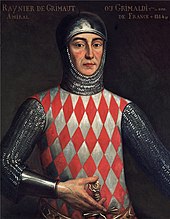
Following a grant of land from Emperor Henry VI in 1191, Monaco was refounded in 1215 as a colony of Genoa.[29][30] Monaco was first ruled by a member of the House of Grimaldi in 1297, when Francesco Grimaldi, known as "Malizia" (translated from Italian either as "The Malicious One" or "The Cunning One"), and his men captured the fortress protecting the Rock of Monaco while dressed as Franciscan friars – a monaco in Italian – although this is a coincidence as the area was already known by this name.[31]
Francesco was evicted a few years later by the Genoese forces, and the struggle over "the Rock" continued for another century.[32] The Grimaldi family was Genoese and the struggle was something of a family feud. The Genoese engaged in other conflicts, and in the late 1300s Genoa lost Monaco after fighting the Crown of Aragon over Corsica.[33] Aragon eventually became part of a united Spain, and other parts of the land grant came to be integrated piecemeal into other states. Between 1346 and 1355, Monaco annexed the towns of Menton and Roquebrune, increasing its territory by almost ten times.[33]
1400–1800

In 1419, the Grimaldi family purchased Monaco from the Crown of Aragon and became the official and undisputed rulers of "the Rock of Monaco". In 1612,
The princes of Monaco thus became vassals of the French kings while at the same time remaining sovereign princes.[36] Though successive princes and their families spent most of their lives in Paris, and intermarried with French and Italian nobilities, the House of Grimaldi is Italian. The principality continued its existence as a protectorate of France until the French Revolution.[37]
19th century

In 1793, Revolutionary forces captured Monaco and until 1814 it was occupied by the French (in this period much of Europe had been overrun by the French armies under the command of Napoleon Bonaparte).[35][38] The principality was reestablished in 1814 under the Grimaldis, only to be designated a protectorate of the Kingdom of Sardinia by the Congress of Vienna in 1815.[38] Monaco remained in this position until 1860 when, by the Treaty of Turin, the Sardinian forces pulled out of the principality; the surrounding County of Nice (as well as Savoy) was ceded to France.[39] Monaco became a French protectorate once again.
Before this time there was unrest in Menton and Roquebrune, where the townspeople had become weary of heavy taxation by the Grimaldi family. They declared their independence as the Free Cities of Menton and Roquebrune, hoping for annexation by Sardinia. France protested. The unrest continued until Charles III of Monaco gave up his claim to the two mainland towns (some 95% of the principality at the time) that had been ruled by the Grimaldi family for over 500 years.[40]
These were ceded to France in return for 4,100,000 francs.[41] The transfer and Monaco's sovereignty were recognised by the Franco-Monégasque Treaty of 1861. In 1869, the principality stopped collecting income tax from its residents—an indulgence the Grimaldi family could afford to entertain thanks solely to the extraordinary success of the casino.[42] This made Monaco not only a playground for the rich, but a favoured place for them to live.[43]
20th century

Until the Monégasque Revolution of 1910 forced the adoption of the 1911 Constitution of Monaco, the princes of Monaco were absolute rulers.[44] The new constitution slightly reduced the autocratic rule of the Grimaldi family and Prince Albert I soon suspended it during the First World War.
In July 1918, a new Franco-Monégasque Treaty was signed, providing for limited French protection over Monaco. The treaty, endorsed in 1919 by the Treaty of Versailles, established that Monégasque international policy would be aligned with French political, military and economic interests. It also resolved the Monaco succession crisis.
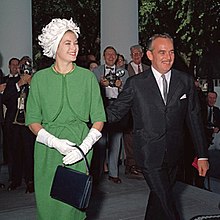
In 1943, the Italian Army
Rainier III, succeeded to the throne on the death of his grandfather, Prince Louis II, in 1949, and then ruled until 2005. On 19 April 1956, Prince Rainier married the American actress Grace Kelly, an event that was widely televised and covered in the popular press, focusing the world's attention on the tiny principality.[48]
A 1962 amendment to the constitution abolished capital punishment, provided for women's suffrage and established a Supreme Court of Monaco to guarantee fundamental liberties. In 1963, a crisis developed when Charles de Gaulle blockaded Monaco, angered by its status as a tax haven for wealthy French citizens.[49]
In 1993, the Principality of Monaco became a member of the United Nations, with full voting rights.[39][50]
21st century

In 2002, a new treaty between France and Monaco specified that, should there be no heirs to carry on the Grimaldi dynasty, the principality would still remain an independent nation rather than revert to France. Monaco's military defense is still the responsibility of France.[51][52]
On 31 March 2005,
In 2015, Monaco unanimously approved a modest land reclamation expansion intended primarily to accommodate desperately needed housing and a small green/park area.[57] Monaco had previously considered an expansion in 2008, but had called it off.[57] The plan is for about six hectares (15 acres) of apartment buildings, parks, shops and offices to a land value of about 1 billion euros.[58] The development will be adjacent to the Larvotto district and also will include a small marina.[58][59] There were four main proposals, and the final mix of use will be finalised as the development progresses.[60] The name for the new district is Anse du Portier.[59]
On 29 February 2020, Monaco announced its first case of
On 3 September 2020, the first Monégasque satellite, OSM-1 CICERO, was launched into space from French Guiana, France aboard a Vega rocket.[63] The satellite was built in Monaco by Orbital Solutions Monaco.
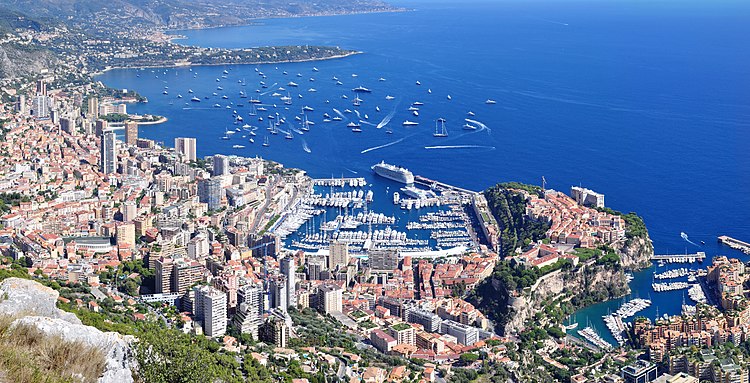
Government

Politics

Monaco has been governed under a
Under the 1962 Constitution of Monaco, the prince shares his veto power with the unicameral National Council.[67] The 24 members of the National Council are elected for five-year terms; 16 are chosen through a majority electoral system and 8 by proportional representation.[68] All legislation requires the approval of the National Council. Following the 2023 Monegasque general election, all 24 seats are held by the pro-monarchist Monegasque National Union.[69]
The principality's city affairs are managed by the
Members of the judiciary of Monaco are appointed by the Sovereign Prince. Key positions within the judiciary are held by French magistrates, proposed by the Government of France. Monaco currently has three examining magistrates.[74]
Security
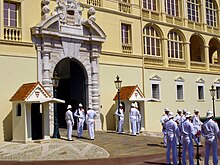
The wider defence of the nation is provided by France. Monaco has no navy or air force, but on both a per-capita and per-area basis, Monaco has one of the largest police forces (515 police officers for about 38,000 people) and police presences in the world.[75] Its police includes a special unit which operates patrol and surveillance boats jointly with the military. Police forces in Monaco are commanded by a French officer.[76]
There is also a small
Geography

Monaco is a sovereign city-state, with five quarters and ten wards,[80] located on the French Riviera in Western Europe. It is bordered by France's Alpes-Maritimes department on three sides, with one side bordering the Mediterranean Sea. Its centre is about 16 km (9.9 mi) from Italy and only 13 km (8.1 mi) northeast of Nice.[50]
It has an area of 2.1 km2 (0.81 sq mi), or 208 ha (510 acres), and a population of 38,400,
The highest point in the country is at the access to the Patio Palace residential building on the
Saint-Jean brook is the longest flowing body of water, around 0.19 km (190 m; 0.12 mi; 620 ft) in length, and Fontvieille is the largest lake, approximately 0.5 ha (5,000 m2; 0 acres; 54,000 sq ft) in area.[86] Monaco's most populated quartier is Monte Carlo, and the most populated ward is Larvotto/Bas Moulins.[87]
After a recent[

Administrative divisions
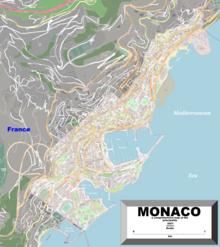
Monaco is the
- Monaco-Ville, the old city and seat of government of the principality on a rocky promontory extending into the Mediterranean, known as the Rock of Monaco, or simply "The Rock";
- Monte Carlo, the principal residential and resort area with the Monte Carlo Casino in the east and northeast;
- La Condamine, the southwestern section including the port area, Port Hercules.
The municipalities were merged into one in 1917,[98][how?] and they were accorded the status of Wards or Quartiers thereafter.
- Fontvieille was added as a fourth ward, a newly constructed area claimed from the sea in the 1970s;
- Moneghettibecame the fifth ward, created from part of La Condamine;
- Larvotto became the sixth ward, created from part of Monte Carlo;
- La Rousse/Saint Roman(including Le Ténao) became the seventh ward, also created from part of Monte Carlo.
Subsequently, three additional wards were created, but then again were dissolved in 2013:
- Saint Michel, created from part of Monte Carlo;
- La Colle, created from part of La Condamine;
- Les Révoires, also created from part of La Condamine.
Most of Saint Michel became part of Monte Carlo again in 2013. La Colle and Les Révoires were merged the same year as part of a redistricting process, where they became part of the larger Jardin Exotique ward. An additional ward was planned by new land reclamation to be settled beginning in 2014[99] but Prince Albert II announced in his 2009 New Year Speech that he had ended plans due to the economic climate at the time.[100] Prince Albert II in mid-2010 firmly restarted the programme.[101][102] In 2015, a new development called Anse du Portier was announced.[59]
Traditional quarters and modern geographic areas
The four traditional quartiers of Monaco are
Wards

For town planning purposes, a sovereign ordinance in 1966 divided the principality into reserved sectors, "whose current character must be preserved", and wards. The number and boundaries of these sectors and wards have been modified several times. The latest division dates from 2013 and created two reserved sectors and seven wards. A new 6-hectare district, Le Portier, is currently being built on the sea.
| Wards | Area | |||||
|---|---|---|---|---|---|---|
| in m2 | in % | |||||
| Reserved Sectors | ||||||
Monaco-Ville |
Reserved Sectors | 196,491 | 9,7 % | |||
| Ravin de Sainte-Dévote | Reserved Sectors | 23,485 | 1,2 % | |||
| Wards | ||||||
| La Condamine | Quartier ordonnancé | 295,843 | 14,6 % | |||
| Fontvieille | Quartier ordonnancé | 329,516 | 16,3 % | |||
| Larvotto | Quartier ordonnancé | 217,932 | 10,8 % | |||
| Jardin Exotique | Quartier ordonnancé | 234,865 | 11,6 % | |||
| Les Moneghetti | Quartier ordonnancé | 115,196 | 5,7 % | |||
Monte-Carlo |
Quartier ordonnancé | 436,760 | 21,5 % | |||
| La Rousse | Quartier ordonnancé | 176,888 | 8,7 % | |||
| Total | 2,026,976 | 100,0 % | ||||
Note: for statistical purposes, the Wards of Monaco are further subdivided into 178 city blocks (îlots), which are comparable to the census blocks in the United States.[87]

Architecture
Monaco exhibits a wide range of architecture, but the principality's signature style, particularly in Monte Carlo, is that of the Belle Époque. It finds its most florid expression in the 1878–9 Casino and the Salle Garnier created by Charles Garnier and Jules Dutrou. Decorative elements include turrets, balconies, pinnacles, multi-coloured ceramics, and caryatids. These were blended to create a picturesque fantasy of pleasure and luxury, and an alluring expression of how Monaco sought and still seeks, to portray itself.[107] This capriccio of French, Italian, and Spanish elements were incorporated into hacienda villas and apartments. Following major development in the 1970s, Prince Rainier III banned high-rise development in the principality. His successor, Prince Albert II, overturned this Sovereign Order.[108] In recent years[when?] the accelerating demolition of Monaco's architectural heritage, including its single-family villas, has created dismay.[109] The principality has no heritage protection legislation.[110]
Climate
Monaco has a
| Climate data for Monaco (1981–2010 averages, extremes 1966–present) | |||||||||||||
|---|---|---|---|---|---|---|---|---|---|---|---|---|---|
| Month | Jan | Feb | Mar | Apr | May | Jun | Jul | Aug | Sep | Oct | Nov | Dec | Year |
| Record high °C (°F) | 19.9 (67.8) |
23.2 (73.8) |
25.6 (78.1) |
26.2 (79.2) |
30.3 (86.5) |
32.5 (90.5) |
34.4 (93.9) |
34.5 (94.1) |
33.1 (91.6) |
29.0 (84.2) |
25.0 (77.0) |
22.3 (72.1) |
34.5 (94.1) |
| Mean daily maximum °C (°F) | 13.0 (55.4) |
13.0 (55.4) |
14.9 (58.8) |
16.7 (62.1) |
20.4 (68.7) |
23.7 (74.7) |
26.6 (79.9) |
26.9 (80.4) |
24.0 (75.2) |
20.6 (69.1) |
16.5 (61.7) |
13.9 (57.0) |
19.2 (66.6) |
| Daily mean °C (°F) | 10.2 (50.4) |
10.2 (50.4) |
12.0 (53.6) |
13.8 (56.8) |
17.5 (63.5) |
20.9 (69.6) |
23.8 (74.8) |
24.2 (75.6) |
21.1 (70.0) |
17.9 (64.2) |
13.8 (56.8) |
11.2 (52.2) |
16.4 (61.5) |
| Mean daily minimum °C (°F) | 7.4 (45.3) |
7.4 (45.3) |
9.1 (48.4) |
10.9 (51.6) |
14.6 (58.3) |
18.0 (64.4) |
21.0 (69.8) |
21.4 (70.5) |
18.3 (64.9) |
15.2 (59.4) |
11.2 (52.2) |
8.5 (47.3) |
13.6 (56.5) |
| Record low °C (°F) | −3.1 (26.4) |
−5.2 (22.6) |
−3.1 (26.4) |
3.8 (38.8) |
7.5 (45.5) |
9.0 (48.2) |
10.5 (50.9) |
12.4 (54.3) |
10.5 (50.9) |
6.5 (43.7) |
1.6 (34.9) |
−1.0 (30.2) |
−5.2 (22.6) |
| Average precipitation mm (inches) | 67.7 (2.67) |
48.4 (1.91) |
41.2 (1.62) |
71.3 (2.81) |
49.0 (1.93) |
32.6 (1.28) |
13.7 (0.54) |
26.5 (1.04) |
72.5 (2.85) |
128.7 (5.07) |
103.2 (4.06) |
88.8 (3.50) |
743.6 (29.28) |
| Average precipitation days (≥ 1.0 mm) | 6.0 | 4.9 | 4.5 | 7.3 | 5.5 | 4.1 | 1.7 | 2.5 | 5.1 | 7.3 | 7.1 | 6.5 | 62.4 |
| Mean monthly sunshine hours | 149.8 | 158.9 | 185.5 | 210.0 | 248.1 | 281.1 | 329.3 | 296.7 | 224.7 | 199.0 | 155.2 | 136.5 | 2,574.7 |
| Source 1: Météo France[115]
| |||||||||||||
| Source 2: Monaco website (sun only)[116] | |||||||||||||
| Climate data for Monaco | |||||||||||||
|---|---|---|---|---|---|---|---|---|---|---|---|---|---|
| Month | Jan | Feb | Mar | Apr | May | Jun | Jul | Aug | Sep | Oct | Nov | Dec | Year |
| Average sea temperature °C (°F) | 13.4 (56.2) |
13.0 (55.5) |
13.4 (56.1) |
14.6 (58.4) |
18.0 (64.3) |
21.8 (71.3) |
23.1 (73.6) |
23.6 (74.4) |
22.2 (71.9) |
19.6 (67.2) |
17.4 (63.3) |
14.9 (58.9) |
17.9 (64.3) |
| Source: Weather Atlas[117] | |||||||||||||


